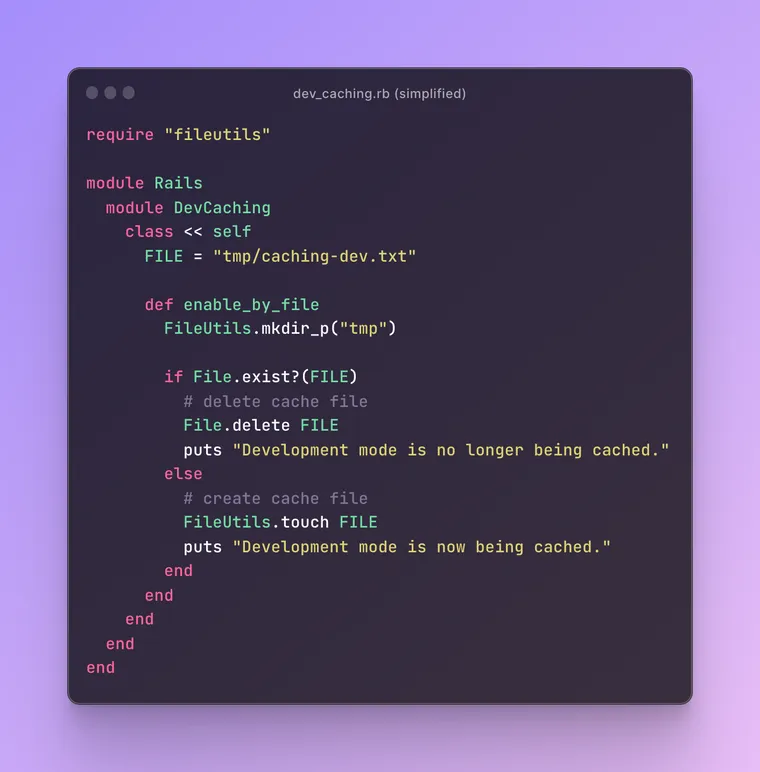The rails dev:cache command toggles caching in development.By default, Rails enables caching only in production environment. To enable it in the development mode, you can run rails dev:cache command. To disable it, re-run the command.
$ bin/rails dev:cache
Development mode is now being cached.
$ bin/rails dev:cache
Development mode is no longer being cached.Behind the scenes, it's implemented as a Thor command that delegates to the Rails::DevCaching module.
# railties/lib/rails/commands/dev/dev_command.rb
require "rails/dev_caching"
module Rails
module Command
class DevCommand < Base
desc "cache", "Toggle development mode caching on/off"
def cache
Rails::DevCaching.enable_by_file
end
end
end
endThe DevCaching::enable_by_file method does the following:
- Create a
tmpdirectory if it doesn't exist. - If the caching file (named
caching-dev.txt) is present inside thetmpdirectory, it means caching is enabled. Delete that file to disable it. Otherwise, create it to enable caching. - Finally, touch the
restart.txtfile to instruct Rails to restart the app.
# railties/lib/rails/dev_caching.rb
require "fileutils"
module Rails
module DevCaching
class << self
FILE = "tmp/caching-dev.txt"
def enable_by_file
FileUtils.mkdir_p("tmp")
if File.exist?(FILE)
delete_cache_file
puts "Development mode is no longer being cached."
else
create_cache_file
puts "Development mode is now being cached."
end
FileUtils.touch "tmp/restart.txt"
end
end
end
endHow Rails Uses the Caching File?
When your Rails application starts, it checks for the presence of the caching file above, and if it exists, it does the following:
- Enable
perform_cachingandenable_fragment_cache_loggingon the controller. - Set the cache store to
:memory_store. - Add the
Cache-Controlheader to public with max-age set to two days.
Otherwise, it disables caching and uses the :null_store.
# config/environments/development.rb
if Rails.root.join("tmp/caching-dev.txt").exist?
config.action_controller.perform_caching = true
config.action_controller.enable_fragment_cache_logging = true
config.cache_store = :memory_store
config.public_file_server.headers = {
"Cache-Control" => "public, max-age=#{2.days.to_i}"
}
else
config.action_controller.perform_caching = false
config.cache_store = :null_store
endperform_cachingconfigures whether the application should perform the caching features provided by Action Controller or not.enable_fragment_cache_loggingdetermines whether to log fragment cache reads and writes in a verbose format.cache_storeconfigures which cache store to use for Rails caching.
The above settings instruct Rails to perform caching. How it implements it, well, that's a topic for another blog post. Stay tuned.
That's a wrap. I hope you liked this article and you learned something new.
As always, if you have any questions or feedback, didn't understand something, or found a mistake, please leave a comment below or send me an email. I reply to all emails I get from developers, and I look forward to hearing from you.
If you'd like to receive future articles directly in your email, please subscribe to my blog. If you're already a subscriber, thank you.

